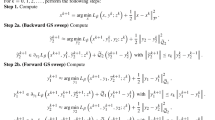Abstract
Regularization techniques have been proved useful in an enormous variety of sparse optimization problem. In this paper, we introduce a new formulation of regularization with a hybrid \(L_2{\text {-}}L_p~(0< p <1)\) norm. Then we model a sparse optimization problem with hybrid \(L_2{\text {-}}L_p\) regularization. For solving the problem, we derive its local optimality conditions and develop a hybrid \(L_2{\text {-}}L_p\) algorithm. Moreover, we analyze the convergence of the algorithm. Finally, we apply our model and algorithm to the image recovery and deblurring for the magnetic resonance images of the brain. The numerical tests show that the effects of the recovery and deblurred images, respectively, obtained by the hybrid \(L_2{\text {-}}L_p\) algorithm with the suitable parameter p are better than those of other three algorithms, compared with the values of the signal-to-noise ratio.





Similar content being viewed by others
References
Bai MZ, Ren CY, Liu Y (2015a) A note of reduced dimension optimization algorithm of assignment problem. J Comb Optim 30(4):841–849
Bai YQ, Han X, Chen T, Yu H (2015b) Quadratic kernel-free least squares support vector machine for target diseases classification. J Comb Optim 30(4):850–870
Beck A, Teboulle M (2009) A fast iterative shrinkage-thresholding algorithm for linear inverse problems. Siam J Imaging Sci 2(1):183–202
Candès EJ, Tao T (2005) Decoding by linear programming. IEEE Trans Inf Theory 51(12):4203–4215
Cao WF, Sun J, Xu ZB (2013) Fast image deconvolution using closed-form thresholding formulas of \(l_q(q=\frac{1}{2},\frac{2}{3})\) regularization. J Vis Commun Image R 24(1):31–41
Chen XJ, Zhou WJ (2014) Convergence of the reweighted \(l_1\) minimization algorithm for \(l_2-l_p\) minimization. SIAM J Comput 59(1–2):47–61
Chen XJ, Ge DD, Wang ZZ, Ye YY (2014) Complexity of unconstrained \(l_2-l_p\) minimization. Math Program 143:371–383
Chen X, Fan ZP, Li ZW, Han XL, Zhang X, Jia HC (2015) A two-stage method for member selection of emergency medical service. J Comb Optim 30(4):871–891
Cheng WY, Li DH (2018) A preconditioned conjugate gradient method with active set strategy for \(l_1\)-regularized least squares. J Oper Res Soc China 6:571–585
Daubechies I, Defrise M, Christine DM (2004) An iterative thresholding algorithm for linear inverse problems with a sparsity constraint. Commun Pure Appl Math 57(11):1413–1457
Donoho DL (1995) De-noising by soft-thresholding. IEEE Trans Inf Theory 41(3):613–627
Donoho DL (2006) Compressed sensing. IEEE Trans Inf Theory 52(4):1289–1306
Fan J, Li R (2001) Variable selection via nonconcave penalized likelihood and its oracle properties. J Am Stat Assoc 96(45):1348–1360
Gai L, Ji JD (2019) An integrated method to solve the healthcare facility layout problem under area constraints. J Comb Optim 37(1):95C113
Jiang S, Fang SC, An Q, Lavery JE (2019) A sub-one quasi-norm-based similarity measure for collaborative filtering in recommender systems. Inform Sci 487(2019):142C155
Lai MJ, Wang JY (2011) An unconstrained \(l_q\) minimization with \(0<q\le 1\) for sparse solution of underdetermined linear systems. SIAM J Optim 21(1):82–101
Li J, Dong M, Ren YJ, Yin KQ (2015) How patient compliance impacts the recommendations for colorectal cancer screening. J Comb Optim 30(4):920–937
Li Q, Bai YQ, Yu CJ, Yuan YX (2019) A new piecewise quadratic approximation approach for \(l_0\) norm minimization problem. Sci China Math 62(1):185–204
Lou YF, Yin PH, He Q, Xin J (2015) Computing sparse representation in a highly coherent dictionary based on difference of \(l_1\) and \(l_2\). J Sci Comput 64(1):178–196
Lustig M, Donoho DL, Pauly JM (2007) Sparse mri: the application of compressed sensing for rapid mr imaging. Magn Reson Med 58:1182–1195
Meinshausen N, Yu B (2009) Lasso-type recovery of sparse representations for high-dimensional data. Ann Stat 37(1):246–270
Natraajan BK (1995) Sparse approximate solutions to linear systems. SIAM J Comput 24(2):227–234
Tibshirani R (1996) Regression shrinkage and selection via the lasso. J R Stat Soc B 58(1):267–288
Wright J, Yang AY, Ganesh A, Sastry S, Ma Y (2009) Robust face recognition via sparse representation. IEEE Trans Pattern Anal 31(2):210–227
Xu ZB, Chang XY, Xu FM, Zhang H (2012) \(l_{1/2}\) regularization: a thresholding representation theory and a fast solver. IEEE Trans Neural Netw Learn 23(7):1013–1027
Yang Y, Shen B, Gao W, Liu Y, Zhong LW (2015) A surgical scheduling method considering surgeons preferences. J Comb Optim 30(4):1016–1026
Zhong LW, Bai YQ (2019) Three-sided stable matching problem with two of them as cooperative partners. J Comb Optim 37(1):286C292
Zou H (2006) The adaptive lasso and its oracle properties. J Am Stat Assoc 101(476):1418–1429
Author information
Authors and Affiliations
Corresponding author
Additional information
Publisher's Note
Springer Nature remains neutral with regard to jurisdictional claims in published maps and institutional affiliations.
This work was supported by the National Natural Science Foundations of China (Grant Number 11771275).
Rights and permissions
About this article
Cite this article
Gao, X., Bai, Y. & Li, Q. A sparse optimization problem with hybrid \(L_2{\text {-}}L_p\) regularization for application of magnetic resonance brain images. J Comb Optim 42, 760–784 (2021). https://doi.org/10.1007/s10878-019-00479-x
Published:
Issue Date:
DOI: https://doi.org/10.1007/s10878-019-00479-x
Keywords
- Sparse optimization
- Hybrid \(L_2{\text {-}}L_p\) regularization
- Optimality conditions
- Magnetic resonance brain images
- Image recovery and deblurring




